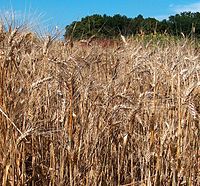
Photo from wikipedia
This is the first genetic study reporting on the interaction and molecular mapping of resistance to the barley grass stripe rust pathogen (Puccinia striiformis f. sp. pseudo-hordei, Psph) in common… Click to show full abstract
This is the first genetic study reporting on the interaction and molecular mapping of resistance to the barley grass stripe rust pathogen (Puccinia striiformis f. sp. pseudo-hordei, Psph) in common wheat. Seedlings of 638 wheat accessions were tested and it was determined that wheat is a near-nonhost to Psph based on rare susceptibility observed in <2% of commercial cultivars and <5% of wheat landraces. As previously observed for P. striiformis f. sp. tritici (Pst), the Australian cultivar Teal was highly susceptible to Psph. In contrast, a selection of cv. Avocet carrying complementary resistance genes Yr73 and Yr74 (Avocet R; AvR) was resistant. The Teal × AvR (T/A) doubled haploid (DH) population was used to map resistance in AvR to Psph. Infection types on the T/A DH lines inoculated with Psph and Pst indicated that all DH lines carrying both Yr73 and Yr74 were also resistant to Psph; however, fewer DH lines were susceptible to Psph than expected, suggesting the resistance was more complex. QTL analysis using 9053 DArT-Seq markers determined that resistance to Psph was polygenically inherited and mapped to chromosomes 3A, 3D, 4A and 5B. The 3DL and 5BL markers co-located with Yr73 and Yr74, suggesting an overlap between host and non-host resistance mechanisms.
Journal Title: Plant Pathology
Year Published: 2017
Link to full text (if available)
Share on Social Media: Sign Up to like & get
recommendations!